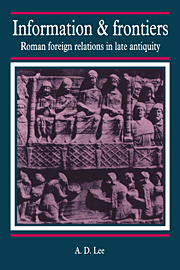Book contents
- Frontmatter
- Contents
- Preface
- Chronological list of selected Roman emperors (early third to early seventh century)
- Chronological list of Sasanian kings (220s–628)
- Map 1 The Middle East in late antiquity
- Map 2 Northern Mesopotamia and adjacent regions
- Map 3 The middle and lower Danube and adjacent regions
- Map 4 The Rhine and upper Danube and adjacent regions
- List of abbreviations
- Introduction
- PART I CONTEXTS
- PART II INFORMATION AND UNCERTAINTY
- PART III SOURCES OF INFORMATION
- Select bibliography
- Index of sources
- General index
- Frontmatter
- Contents
- Preface
- Chronological list of selected Roman emperors (early third to early seventh century)
- Chronological list of Sasanian kings (220s–628)
- Map 1 The Middle East in late antiquity
- Map 2 Northern Mesopotamia and adjacent regions
- Map 3 The middle and lower Danube and adjacent regions
- Map 4 The Rhine and upper Danube and adjacent regions
- List of abbreviations
- Introduction
- PART I CONTEXTS
- PART II INFORMATION AND UNCERTAINTY
- PART III SOURCES OF INFORMATION
- Select bibliography
- Index of sources
- General index
Summary
SCOPE AND AIMS
this study is concerned with the foreign relations of the Roman empire during late antiquity, defined here as the period from the early third to the early seventh century ad. It is not, however, a general history of late Roman foreign relations. In the first place, it pursues a particular theme within that field – the role of information. And secondly, it focuses on late Roman relations with two particular regions – Sasanian Persia in the east, and the areas adjacent to the empire's northern Continental frontier, occupied by a number of different peoples of Germanic and central Asiatic origin during the course of late antiquity. At the same time, this study deals with much more than just military and diplomatic affairs: the particular questions it pursues entail consideration of the broader context within which relations were played out, notably the socio-cultural character of the relevant frontier regions, and the differing levels of organisational complexity among the empire's neighbours.
Numerous studies have been devoted to elucidating various aspects of the history and conduct of late Roman foreign relations, but the role of information has received little systematic attention. Yet there can be no doubt as to its importance.
- Type
- Chapter
- Information
- Information and FrontiersRoman Foreign Relations in Late Antiquity, pp. 1 - 12Publisher: Cambridge University PressPrint publication year: 1993
- 2
- Cited by

